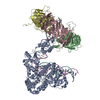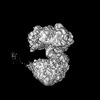+ Open data
Open data
- Basic information
Basic information
| Entry | Database: PDB / ID: 9cl7 | |||||||||||||||||||||
|---|---|---|---|---|---|---|---|---|---|---|---|---|---|---|---|---|---|---|---|---|---|---|
| Title | Cryo-EM structure of FAN1-PCNA-DNA in final state | |||||||||||||||||||||
 Components Components |
| |||||||||||||||||||||
 Keywords Keywords | DNA BINDING PROTEIN / nuclease / CAG expansion / DNA repair / Huntington's disease / PROTEIN BINDING | |||||||||||||||||||||
| Function / homology |  Function and homology information Function and homology informationflap-structured DNA binding / phosphodiesterase I / positive regulation of deoxyribonuclease activity / dinucleotide insertion or deletion binding / PCNA-p21 complex / mitotic telomere maintenance via semi-conservative replication / 5'-flap endonuclease activity / purine-specific mismatch base pair DNA N-glycosylase activity / nuclear lamina / positive regulation of DNA-directed DNA polymerase activity ...flap-structured DNA binding / phosphodiesterase I / positive regulation of deoxyribonuclease activity / dinucleotide insertion or deletion binding / PCNA-p21 complex / mitotic telomere maintenance via semi-conservative replication / 5'-flap endonuclease activity / purine-specific mismatch base pair DNA N-glycosylase activity / nuclear lamina / positive regulation of DNA-directed DNA polymerase activity / Polymerase switching / MutLalpha complex binding / Telomere C-strand (Lagging Strand) Synthesis / Processive synthesis on the lagging strand / PCNA complex / Removal of the Flap Intermediate / Hydrolases; Acting on ester bonds; Endodeoxyribonucleases producing 5'-phosphomonoesters / Processive synthesis on the C-strand of the telomere / Polymerase switching on the C-strand of the telomere / Mismatch repair (MMR) directed by MSH2:MSH3 (MutSbeta) / Mismatch repair (MMR) directed by MSH2:MSH6 (MutSalpha) / Transcription of E2F targets under negative control by DREAM complex / Removal of the Flap Intermediate from the C-strand / ubiquitin-modified protein reader activity / replisome / response to L-glutamate / 5'-3' exonuclease activity / phosphodiesterase I activity / response to dexamethasone / histone acetyltransferase binding / DNA polymerase processivity factor activity / leading strand elongation / G1/S-Specific Transcription / nuclear replication fork / replication fork processing / SUMOylation of DNA replication proteins / PCNA-Dependent Long Patch Base Excision Repair / response to cadmium ion / translesion synthesis / estrous cycle / mismatch repair / interstrand cross-link repair / intercellular bridge / cyclin-dependent protein kinase holoenzyme complex / base-excision repair, gap-filling / DNA polymerase binding / liver regeneration / epithelial cell differentiation / positive regulation of DNA repair / TP53 Regulates Transcription of Genes Involved in G2 Cell Cycle Arrest / Translesion synthesis by REV1 / Translesion synthesis by POLK / Translesion synthesis by POLI / positive regulation of DNA replication / Gap-filling DNA repair synthesis and ligation in GG-NER / replication fork / nuclear estrogen receptor binding / male germ cell nucleus / nucleotide-excision repair / Fanconi Anemia Pathway / Termination of translesion DNA synthesis / Recognition of DNA damage by PCNA-containing replication complex / Translesion Synthesis by POLH / double-strand break repair via homologous recombination / receptor tyrosine kinase binding / HDR through Homologous Recombination (HRR) / Dual Incision in GG-NER / cellular response to xenobiotic stimulus / cellular response to hydrogen peroxide / Dual incision in TC-NER / Gap-filling DNA repair synthesis and ligation in TC-NER / cellular response to UV / response to estradiol / E3 ubiquitin ligases ubiquitinate target proteins / heart development / chromatin organization / damaged DNA binding / chromosome, telomeric region / nuclear body / cilium / DNA repair / centrosome / chromatin binding / chromatin / protein-containing complex binding / enzyme binding / magnesium ion binding / negative regulation of transcription by RNA polymerase II / extracellular exosome / zinc ion binding / nucleoplasm / identical protein binding / nucleus / cytosol Similarity search - Function | |||||||||||||||||||||
| Biological species |  Homo sapiens (human) Homo sapiens (human)synthetic construct (others) | |||||||||||||||||||||
| Method | ELECTRON MICROSCOPY / single particle reconstruction / cryo EM / Resolution: 3.83 Å | |||||||||||||||||||||
 Authors Authors | Li, F. / Pluciennik, A. | |||||||||||||||||||||
| Funding support |  United States, 1items United States, 1items
| |||||||||||||||||||||
 Citation Citation |  Journal: Nat Commun / Year: 2025 Journal: Nat Commun / Year: 2025Title: Structural and molecular basis of PCNA-activated FAN1 nuclease function in DNA repair. Authors: F Li / A S Phadte / M Bhatia / S Barndt / A R Monte Carlo Iii / C-F D Hou / R Yang / S Strock / A Pluciennik /  Abstract: FAN1 is a DNA dependent nuclease whose proper function is essential for maintaining human health. For example, a genetic variant in FAN1, Arg507 to His hastens onset of Huntington's disease, a repeat ...FAN1 is a DNA dependent nuclease whose proper function is essential for maintaining human health. For example, a genetic variant in FAN1, Arg507 to His hastens onset of Huntington's disease, a repeat expansion disorder for which there is no cure. How the Arg507His mutation affects FAN1 structure and enzymatic function is unknown. Using cryo-EM and biochemistry, we have discovered that FAN1 arginine 507 is critical for its interaction with PCNA, and mutation of Arg507 to His attenuates assembly of the FAN1-PCNA complex on a disease-relevant extrahelical DNA extrusions formed within DNA repeats. This mutation concomitantly abolishes PCNA-FAN1-dependent cleavage of such extrusions, thus unraveling the molecular basis for a specific mutation in FAN1 that dramatically hastens the onset of Huntington's disease. These results underscore the importance of PCNA to the genome stabilizing function of FAN1. | |||||||||||||||||||||
| History |
|
- Structure visualization
Structure visualization
| Structure viewer | Molecule:  Molmil Molmil Jmol/JSmol Jmol/JSmol |
|---|
- Downloads & links
Downloads & links
- Download
Download
| PDBx/mmCIF format |  9cl7.cif.gz 9cl7.cif.gz | 294.6 KB | Display |  PDBx/mmCIF format PDBx/mmCIF format |
|---|---|---|---|---|
| PDB format |  pdb9cl7.ent.gz pdb9cl7.ent.gz | Display |  PDB format PDB format | |
| PDBx/mmJSON format |  9cl7.json.gz 9cl7.json.gz | Tree view |  PDBx/mmJSON format PDBx/mmJSON format | |
| Others |  Other downloads Other downloads |
-Validation report
| Summary document |  9cl7_validation.pdf.gz 9cl7_validation.pdf.gz | 1.1 MB | Display |  wwPDB validaton report wwPDB validaton report |
|---|---|---|---|---|
| Full document |  9cl7_full_validation.pdf.gz 9cl7_full_validation.pdf.gz | 1.1 MB | Display | |
| Data in XML |  9cl7_validation.xml.gz 9cl7_validation.xml.gz | 51.2 KB | Display | |
| Data in CIF |  9cl7_validation.cif.gz 9cl7_validation.cif.gz | 78 KB | Display | |
| Arichive directory |  https://data.pdbj.org/pub/pdb/validation_reports/cl/9cl7 https://data.pdbj.org/pub/pdb/validation_reports/cl/9cl7 ftp://data.pdbj.org/pub/pdb/validation_reports/cl/9cl7 ftp://data.pdbj.org/pub/pdb/validation_reports/cl/9cl7 | HTTPS FTP |
-Related structure data
| Related structure data |  45664MC  9cg4C  9chmC  9cmaC M: map data used to model this data C: citing same article ( |
|---|---|
| Similar structure data | Similarity search - Function & homology  F&H Search F&H Search |
- Links
Links
- Assembly
Assembly
| Deposited unit | 
|
|---|---|
| 1 |
|
- Components
Components
| #1: DNA chain | Mass: 14231.137 Da / Num. of mol.: 1 / Source method: obtained synthetically / Source: (synth.) synthetic construct (others) | ||||
|---|---|---|---|---|---|
| #2: DNA chain | Mass: 12256.890 Da / Num. of mol.: 1 / Source method: obtained synthetically / Source: (synth.) synthetic construct (others) | ||||
| #3: Protein | Mass: 28795.752 Da / Num. of mol.: 3 Source method: isolated from a genetically manipulated source Source: (gene. exp.)  Homo sapiens (human) / Gene: PCNA / Production host: Homo sapiens (human) / Gene: PCNA / Production host:  #4: Protein | | Mass: 72856.969 Da / Num. of mol.: 1 Source method: isolated from a genetically manipulated source Source: (gene. exp.)  Homo sapiens (human) / Gene: FAN1, KIAA1018, MTMR15 / Production host: Homo sapiens (human) / Gene: FAN1, KIAA1018, MTMR15 / Production host:  References: UniProt: Q9Y2M0, Hydrolases; Acting on ester bonds; Endodeoxyribonucleases producing 5'-phosphomonoesters, phosphodiesterase I Has protein modification | Y | |
-Experimental details
-Experiment
| Experiment | Method: ELECTRON MICROSCOPY |
|---|---|
| EM experiment | Aggregation state: PARTICLE / 3D reconstruction method: single particle reconstruction |
- Sample preparation
Sample preparation
| Component | Name: Ternary complex of FAN1-PCNA-DNA in final state / Type: COMPLEX / Entity ID: all / Source: RECOMBINANT |
|---|---|
| Source (natural) | Organism:  Homo sapiens (human) Homo sapiens (human) |
| Source (recombinant) | Organism:  |
| Buffer solution | pH: 7.5 |
| Specimen | Embedding applied: NO / Shadowing applied: NO / Staining applied: NO / Vitrification applied: YES |
| Vitrification | Cryogen name: ETHANE / Humidity: 100 % |
- Electron microscopy imaging
Electron microscopy imaging
| Experimental equipment |  Model: Titan Krios / Image courtesy: FEI Company |
|---|---|
| Microscopy | Model: TFS KRIOS |
| Electron gun | Electron source:  FIELD EMISSION GUN / Accelerating voltage: 300 kV / Illumination mode: OTHER FIELD EMISSION GUN / Accelerating voltage: 300 kV / Illumination mode: OTHER |
| Electron lens | Mode: OTHER / Nominal defocus max: 2500 nm / Nominal defocus min: 500 nm |
| Image recording | Electron dose: 50 e/Å2 / Film or detector model: GATAN K3 (6k x 4k) |
- Processing
Processing
| EM software | Name: PHENIX / Category: model refinement | ||||||||||||||||||||||||
|---|---|---|---|---|---|---|---|---|---|---|---|---|---|---|---|---|---|---|---|---|---|---|---|---|---|
| CTF correction | Type: PHASE FLIPPING ONLY | ||||||||||||||||||||||||
| 3D reconstruction | Resolution: 3.83 Å / Resolution method: FSC 0.143 CUT-OFF / Num. of particles: 220000 / Symmetry type: POINT | ||||||||||||||||||||||||
| Refine LS restraints |
|
 Movie
Movie Controller
Controller






 PDBj
PDBj













































